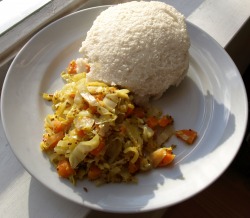The Ismaili Culture
Food – Kenyan and Indian

Ugali seved with a vegetable stew
Being an Indian, I would typically have curries made from vegetables and chicken with either rice or chapatti (thin wheat bread roasted on a pan). I would usually have this with water or lassi, which is a sort of milk shake made from yoghurt with salt and other spices.
However, there is a lot of Kenyan food that we eat at home sometimes, such as Ugali (A kind of stiff porridge made by boiling flour and water-the flour is usually of maize). This would typically be eaten by Kenyans and would be eaten with some stew, spinach, lamb or any other stew. This meal can be served with kahawa (black coffee) or with water, or chai(tea). On special occasions there may also be nyama choma (grilled meat). After that there may be a serving of fruits or a sweet serving of some sort of pudding, sometimes made out of cassava. The food is served as a group platter and is usually eaten with the hand. However the pudding may require a spoon. However the ugali and stew are eaten with the right hand while sitting on the floor, most times.
The recipe for ugali is:
4 to 6 servings
• Water -- 4 cups
• Salt -- 2 teaspoons
• White cornmeal, finely ground -- 2 cups
Method
1. Bring the water and salt to a boil in a heavy-bottomed saucepan. Stir in the cornmeal slowly, letting it fall though the fingers of your hand.
2. Reduce heat to medium-low and continue stirring regularly, smashing any lumps with a spoon, until the mush pulls away from the sides of the pot and becomes very thick, about 10 minutes. Remove from heat and allow to cool somewhat.
3. Place the ugali into a large serving bowl. Wet your hands with water, form into a ball and serve.
Variations
• White cornmeal is the most commonly used grain for ugali. But you can substitute sorghum, millet or coarse cassava flour.
• More or less water can be added to achieve the consistency you prefer.
• Stir in a little butter if you like for a richer flavor
To get more mouth watering Kenyan recipes visit: http://www.whats4eats.com/africa/kenya-cuisine
<< Previous Next>>
